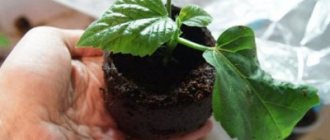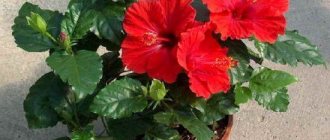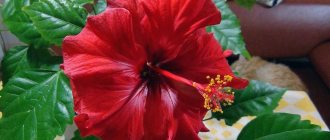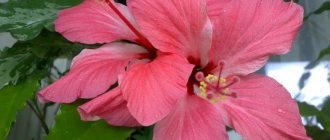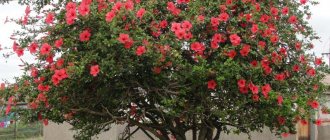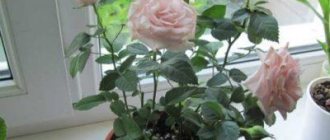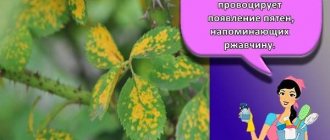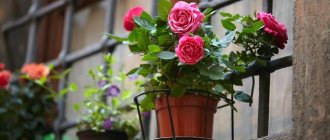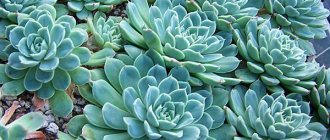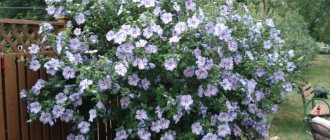- September 25, 2018
- Flowers
- Karmelia
Hibiscus (Chinese rose) is surrounded by many legends, according to which it improves the health of household members, is an absorber of evil forces, and can even help its owner get married or, conversely, scare away all gentlemen. In addition, in addition to her magical powers, she has an attractive appearance, is unpretentious and easy to care for. These arguments helped this flower become one of the favorite species for breeding at home.
What kind of plant
Hibiscus is a genus of flowering plants in the large Malvaceae family. Hibiscus are very diverse and are represented by hundreds of species. They are perennial and annual, tree-like, deciduous and herbaceous, and can grow as a large bush or as a separate flower.
Features of hibiscus:
- The plant can overwinter under shelters and withstand frosts down to minus 30°C.
- Depending on their formation, plants can transform into tree-like and standard forms.
- The height of plants is determined by pruning - the same species can reach a height of half a meter and a couple of meters.
In nature, you can find species of hibiscus that grow up to 20 m in height.
Varieties of hibiscus for growing in the garden
Syrian hibiscus
Garden hibiscus belongs to the most numerous group of flowers. They are divided into herbaceous, tree-like and varietal.
Tree-like (for example, Syrian rose) grows in the form of a small tree. It may be low-growing and branched, or appear as a single-trunked tree. Some species grow up to 6 m high. Herbaceous hibiscus are low-growing. They have powerful and strong shoots, large flowers up to 40 cm in size. They are annuals and perennials. Bush hibiscus are slow-growing flowers with numerous branches. They bloom abundantly and brightly throughout the warm season. The flowers are quite large - 25 cm in diameter.
The most popular types of hibiscus are:
- Syriac . A very beautiful plant with a bright color palette. Sometimes there are two-color varieties. The diameter of the buds is 10 cm. They are simple and double. The plant produces buds for the first time only in the third year of life. In nature, it reaches a height of 6 m. The most popular varieties are: Diana, Pink Giant, Vayelit Ilar Double.
- Hybrid . Occurred by crossing North American species and the bright red swamp. They belong to herbaceous perennials. They are distinguished by large flowers. The best hybrid varieties can be called: Yunost, Late, Pale pink.
- Trifoliate . It is a low-growing plant up to 85 cm. Its flowers are light yellow with a purple center, 4 cm in diameter. It begins to bloom early. By noon the buds have faded. The bush blooms for a month.
Description of appearance
Most of all, our flower lovers know the indoor hibiscus, which they call the Chinese rose. Many considered it boring and unattractive, and it was grown mainly in tubs. In almost every school or clinic one could find a large bush with single red flowers.
In fact, hibiscus is much more diverse. This plant is actively conquering gardens and indoors today. New varieties of hibiscus are diverse - they have different leaves, flowers, and other botanical features. But there are a number of external characteristics common to all hibiscus.
Appearance Features:
- Leaves. Glossy, they look, although rustic, but fresh and elegant. They are oval or ovoid in shape. Their ends are pointed and their edges are jagged. The color is rich, cold green.
- Flowers. They are shaped like small gramophones. They may differ in size and “design”. There are varieties in which the flowers are decorated with fringe along the edge of the petals. The colors of the flowers are very different - there are yellow, red, pink, orange, and purple shades. The diameter of the funnel-shaped flowers is up to 10 cm, but larger specimens may also be found. In the center there is a dark spot - a pistil, in which fused long stamens are concentrated. The length of the latter can reach 10 cm.
- Roots. Powerful, branched, well developed.
Reviews
Hibiscus (Chinese rose) is one of the most beautiful ornamental plants that can be grown at home. Its main advantage is the fact that it does not require careful maintenance, it is a fairly simple process. In addition, it has an attractive appearance and can fit into and decorate any interior. In addition, its life cycle is very long, and during this time the flower becomes a full member of the family.
Another important advantage is the ease of its propagation, especially by cuttings. This makes it suitable for breeding at home.
Where does it grow
Hibiscus is a heat-loving plant and is widespread in countries with tropical and subtropical climates. Some species are also found in temperate latitudes. Representatives of this genus can be found in a variety of countries and continents.
Hibiscus grows mainly in Africa, North and South America, and Europe. In Russia they can be seen in the Caucasus, Crimea and the Far East. But Europeans first encountered this plant in the Hawaiian Islands, from where they brought it first to Europe and then to America.
Attitude to flowers in different countries
0
Source:
Despite the skepticism and contemptuous nickname - muzhegon, in India, hibiscus, on the contrary, is considered a plant that strengthens marriage, and is used during wedding ceremonies as an element of decorations - wreaths and garlands that are exchanged between future spouses. In Malaysia, there is generally a kind of cult of hibiscus. His image is even present on the state emblem. And in the country there is a whole park of such roses, the number of bushes in which exceeds 2000 copies. It is often used for wedding celebrations.
0
Source:
The Chinese rose is also popular in Argentina: in this country, almost every home or office building has at least a couple of pots of hibiscus, and their absence even causes sincere bewilderment among guests and visitors. The local population associates bright red inflorescences with the kindness of a person and the purity of his soul. Hibiscus is an integral part of the local color in Haiti and Hawaii. The locks of local girls greeting tourists are sure to be decorated with at least one hibiscus bud. And a garland, which also has roses woven into it, is placed around the guests’ necks, symbolizing openness and expressing hospitality.
Features of flowering
The main advantage of hibiscus, which gardeners and landscape designers appreciate, is its abundant and beautiful flowering. The flowering of each bud lasts only a couple of days, but in general the flowering can be long - its duration depends on the species and growing conditions.
Flowering Features:
- Hibiscus flowers can be either fragrant or completely devoid of any aroma. Moreover, the latter option is more common.
- The buds usually open in the morning when the sun rises. In the evening, the buds close and fade, and flowering ends. The next morning new flowers will bloom.
- With proper care, from 20 to 50 buds can bloom on each branch at the same time.
- Flowering begins in spring or early summer, and can last until autumn. Indoor hibiscus can bloom from February to October.
The dormant period begins in November and lasts until February. At this time, the room temperature is reduced to +14…+16°C. The flower, even at rest, must receive enough light and water.
Since hibiscus comes from the tropics, it can bloom all year round. True, this is only possible if appropriate conditions are created for it throughout the year.
Caring for hibiscus at home, secrets and difficulties
The plant is absolutely unpretentious and can continue to grow green mass in almost any conditions. However, inappropriate humidity, temperature and improper pruning can cause it to fail to bloom.
Lighting
The light-loving shrub prefers to grow in a well-lit place. However, when choosing a place to place a flower, it is necessary to take into account that direct UV rays can negatively affect its decorative effect. For this reason, it is better to place the plant on eastern or western windowsills.
Lack of light can cause poor flowering or its complete absence.
Therefore, even in the winter season, the plant must receive a sufficient amount of light. To do this, the shrub can be provided with additional lighting using phytolamps.
Temperature and humidity
During the active growing season, which occurs in the warm season, the bush feels good at temperatures from 20 to 24 °C. With the onset of cold weather, it is recommended to provide the plant with a period of rest by reducing the room temperature to 14-16 °C. Such wintering will have a positive effect on the subsequent flowering of the bush.
On a note!
However, cold wintering is not a mandatory rule, but just a recommendation. The bush can overwinter in a warm room.
The flower prefers to grow in humid climates. You can increase air humidity by placing a container with wet expanded clay near the plant. The shrub responds well to daily spraying, especially in summer and winter, when the air in the room becomes dry due to the heat or the operation of heating devices. Flowering shrubs should be sprayed carefully, avoiding water getting on its buds.
Watering and fertilizing
The moisture-loving flower requires frequent and abundant watering, especially during the active growing season. However, moisture should not be allowed to stagnate in a pot or tray. It is better to water the flower immediately after the top layer of the earthen substrate has dried a little. In autumn and winter, the flower does not need so much watering. At this time of year, you can allow the top layer of the soil mixture to dry out completely.
For watering and spraying, it is important to use only soft water at room temperature.
Regular application of fertilizing in the spring and summer plays an important role in the flowering of the bush. A lack of nutrients in the soil can cause the bush to begin dropping buds that have not yet opened. For feeding, you can use liquid complex fertilizers for flowering ornamental crops. The frequency of fertilization is once every 2 weeks.
Trimming and pinching
The pruning procedure plays a vital role in the flowering of the bush. The fact is that buds are formed exclusively on young shoots of the flower, the formation of which is stimulated by pruning. It is recommended to carry out the procedure in the spring, after transplanting the plant.
Hibiscus pruning
During pruning, the shoots are shortened by 1/3 of the total length. Weak, diseased and shoots growing inside the bush are completely removed. It is recommended to treat the cut areas with garden varnish or sprinkle with charcoal. Pinching shoots immediately after the end of the flowering period also stimulates the formation of new lateral shoots.
Preparing for winter
Cold wintering has a positive effect on the splendor and duration of future hibiscus flowering. However, the plant must be properly prepared for the dormant period so as not to injure it by sudden changes. To do this, immediately after the bush has flowered, you can begin to gradually reduce the air temperature in the room.
It is also necessary to reduce the number and abundance of watering, since in a cool room moisture from the soil evaporates much more slowly. In addition, it is recommended to completely abandon the application of fertilizers or reduce the frequency of fertilizing to once every few months.
Planting garden hibiscus
In the garden, hibiscus can be grown both in the ground and in large flowerpots. For planting, seedlings are used - purchased or grown with your own hands.
Garden hibiscus
Disembarkation dates
Hibiscus is planted in open ground/vases twice a year:
- In the spring. It is recommended to plant in May, when the soil has warmed up to +15°C and the threat of return frosts has been eliminated.
- In autumn. Planting at this time of year is undesirable, especially in temperate latitudes. Seedlings rarely have time to take root and grow stronger before frost. If, after all, planting is done in the fall, then the tree trunk circles are carefully mulched, and the seedling itself is wrapped in dense material or covered with spruce branches.
Site selection
In order for a plant to grow and develop quickly, you need to choose the right place for it. The requirements of hibiscus for light, moisture, soil, and the movement of air masses are taken into account.
How to choose a suitable place for planting hibiscus in the garden:
- Lack of bright sun;
- Protection from drafts and strong winds;
- The site should be well drained;
- The soils are loose and nutritious, with a neutral or slightly alkaline reaction.
If the plant is grown by seeds, then sowing begins in mid-winter. Ready seedlings are planted in open ground after stable heat has been established.
Hibiscus domestic
Selection of seedlings
The easiest and fastest way to decorate your dacha with hibiscus is to buy seedlings and plant them in beautiful tubs or in open ground.
How to choose hibiscus seedlings:
- The flower must look healthy;
- It should be visible what color the flowers will be;
- The roots are healthy, without damage.
To check the roots of the plants, just tap the container a little and pull the stem up. After this, you can inspect the root system.
Lighting and air flow for Chinese rose
The Chinese rose, or Chinese hibiscus, prefers rooms with good air circulation and therefore will not grow well in a musty room. Also, if you grow several roses at home, it is better not to place them close to each other and keep them away from direct sunlight and heat. If the plant is grown in hot tropical countries, then you need to choose a place for planting with periodic shading in the case of a flowering specimen. And you can choose permanent shade if the hibiscus does not bloom.
In general, the Chinese rose, or hibiscus (flower of death), a photo of which you can see in the article, is quite tolerant of various conditions; it only does not tolerate extremes, for example, direct sunlight on a windowsill on the south side or cold and shade on the north side. And even at home you can create favorable conditions for growing it without spending a lot of effort.
Planting seedlings
The seedlings do not need any additional procedures; you can safely transplant them into a plot or into a pot of suitable size.
How to plant hibiscus:
- Prepare the soil. Dig up the area in advance, adding peat and sand for digging. You can also add organic matter - humus and compost. For the tub, prepare the mixture. For example, this composition:
- garden soil - 2 parts;
- peat - 4 parts;
- sand - 1 part.
- Dig a hole for planting. Its volume should be such that the seedling fits comfortably in it (about twice the size of the roots). The intervals between adjacent pits are 1.5-2 m.
- Prepare the hole for planting. Place a 10-15 cm layer of drainage on the bottom. This can be pebbles or small crushed stone. Pour sand onto the drainage, then compost.
- Plant a seedling. Carefully remove the seedling from the planting pot. Place the plants in the center of the hole, strictly vertically, and carefully sprinkle its roots with the soil mixture prepared in advance. Make it from a mixture of sand, peat and the top layer of earth removed when digging a hole.
- Complete landing. Form a circle near the trunk - a recess in which water will accumulate during watering.
- Watering. Pour 10 liters of water into the furrow around the seedling.
- Trimming. Immediately after planting, all shoots are shortened by half their length.
Additionally, watch the video instructions on planting hibiscus in the garden:
The root collar of a hibiscus seedling should be slightly below ground level.
If you are going to plant hibiscus in the garden, you usually use purchased planting material for this purpose. Plants can serve as a wonderful decoration for a summer cottage. If winters are harsh, the plants are transplanted into tubs and moved to the basement. Or they carefully insulate the plant.
Planting indoor hibiscus
If the hibiscus is to grow at home, decorating the interior with its appearance, it is necessary to prepare planting containers for it in advance. A seedling for planting can be grown from seeds, but it is easier to buy ready-made seedlings.
Soil preparation
Its development and growth depend on the quality of the soil mixture on which the young hibiscus will grow. The soil in the pot should be fertile, loose, with a neutral reaction.
The optimal composition of the soil mixture for home growing hibiscus:
- leaf soil - 2 parts;
- turf soil - 2 parts;
- humus - 2 parts;
- sand - 1 part;
- wood ash - 0.5 parts.
Another option for soil mixture:
- peat - 2 parts;
- humus - 1 part;
- garden soil - 1 part;
- washed sand - 0.5 parts.
Indoor kibiscus
Peat has high acidity, so for every liter of soil mixture add a quarter cup of wood ash and 1 tbsp. l. complex mineral fertilizer.
Seedling preparation
Once purchased planting material is brought home, it is carefully inspected.
How to check the health of a hibiscus seedling:
- The stems and leaves should not show signs of damage, disease or pests.
- Remove the plant from the planting container as carefully as possible and inspect the roots. There should be no traces of root worms or rot on them. Typically, hibiscus is sold in plastic pots, from which seedlings can be easily removed.
If damage is found on young hibiscus, it is necessary to immediately treat them with appropriate agents against diseases (fungicides) and pests (insecticides).
Possible warning signs:
- Spots and dots;
- Uneven yellowness on leaves;
- Web.
What does hibiscus look like: description
Hibiscus rosa-sinensis is one of 240 species of the genus Hibiscus from the Malvaceae family. May be called rosean or Chinese rose. It has several varieties, one of which is widespread in culture - Cooperi.
The plant's homeland is Indochina and the southern provinces of China, from where hibiscus was introduced into other tropical or subtropical regions. The flower is the national symbol of Malaysia.
The corollas of the Chinese rose are edible, like those of the hibiscus plant (Hibiscus sabdariffa), and are used to make salads and drinks. Hibiscus is used in religious ceremonies, for making cosmetics, dyes, cleaning shoes and measuring the pH level of any solutions.
Description of the plant
Hibiscus is an evergreen shrub, in nature its height is 2.5-6 m, with a crown diameter of 1.5-3 m. In cultivation it is limited to 2-3 m, selection is aimed at reducing the size or slowing growth.
The trunk is round in cross-section, vertical, like the shoots of young specimens. A mature Chinese rose plant can have branches pointing in any direction, even downwards. They quickly become lignified and become tough, like real wood.
Healthy bark is smooth, light, gray with a brownish tint. The root obtained from seeds forms a tap root. Cuttings of Chinese hibiscus cannot grow like this, but they produce strong branched adventitious shoots.
The leaves are alternate, shallowly notched, dark green, shiny. The surface of the plates is smooth and uniform. Varieties may have folds along the veins; the Cooperi variety is variegated.
When and how does hibiscus bloom?
In the homeland of roses, the corollas bloom from March to October. If you care for the Chinese rose correctly, prune it on time, ensure a bright position, cool wintering, hibiscus will bloom at home starting in May.
The plant produces buds on the current year's growth. It is possible that the corollas will appear and open earlier if you do not prune the Chinese rose. But then the flowering will be sparse, the buds stop forming after about 2 months, or 1-2 pieces appear on a large shrub intermittently.
If you follow agricultural practices and timely annual pruning, hibiscus flowering can last 8-10 months.
The corollas of the species plant are simple, red, with 5 petals, about 10 cm in diameter. The pistil is prominent, long, smooth or slightly curved, ending in five fluffy stigmas. Easily visible, bright yellow anthers are attached to the sides in the upper third.
Chinese hibiscus flowers are single, wide bell-shaped. Large rounded petals are smooth or wavy, with a more or less clearly visible vascular pattern. The diameter of the corollas of cultivars reaches 16 cm, there are varieties with a cross section of 20 cm. There are double or simple flowers; in the El Capitolio series they are two-tiered.
The coloring is plain or combined, with a contrasting “eye”, border, specks, strokes, sagging. It was previously believed that there were no blue Chinese hibiscus. Now lavender, lilac and purple colors have been added to the red, yellow, white, pink, orange palette.
The fruit is a five-leaf capsule. Hibiscus seeds rarely ripen at home. Pollination must be carried out manually; as soon as the corollas open, you will have to abandon further flowering - after the ovaries appear, the Chinese rose will begin to shed buds.
When is transplantation and transshipment necessary?
Many people argue about replanting hibiscus - when it is necessary to move the seedling to a new location. The fact is that hibiscus is usually brought from Holland. They grow in pots with excellent soil mixture, which gives them a wonderful appearance.
If suddenly transplanted into a new soil mixture that is less perfect, the plant may react poorly, even to the point of death. Therefore, you need to carefully prepare for transplantation by making the most nutritious mixture possible.
If you still decide to transplant the seedling into a new pot/flowerpot immediately after purchase, then only the transshipment method is used. This method is preferred when transplanting any flowers.
Transplantation is carried out when:
- Plant diseases;
- The appearance of insects in the soil;
- Root rot;
- Incorrect composition of soil mixture.
Plant replanting is carried out with a complete replacement of the soil, and transshipment is carried out along with a lump of earth. In the first case, there is a high risk of damage to the roots, in the second it is minimized.
Planting in a pot
To transplant a seedling into a new container, you need to select a voluminous pot - its diameter should exceed the previous one by 4-5 cm.
The procedure for planting (transferring) hibiscus seedlings:
- Place a layer of expanded clay at the bottom of the pot, and then add some soil. Add some charcoal to it.
- Water the seedling so that the flower is removed from the planting container without damage.
- Remove the seedling from the pot by tapping its walls.
- Place the seedling along with a lump of soil in a new pot so that it sinks a little. This will allow you to add fresh soil after planting.
- Fill the root ball with soil, gently tamping it down with your fingers.
- Place a support. For example, a wooden stick. Tie a plant to it. This will not only support the hibiscus, but will also prevent the pot from tilting and falling over.
- Generously water the planted seedling and cover the pot with film. This will allow the plant to take root faster and better after moving to a new container.
- Using a sharp garden knife, trim the branches to form a compact plant.
When the plant takes root, after a couple of days, the film is removed and it is grown, providing care - watering, fertilizing, etc. The pot is placed in a sunny place and provides fresh air to the flower.
Transplanting into a pot is carried out according to the same scheme, but the pot is filled with soil mixture at least 2/3. Then the flower is planted and its roots are covered with soil.
Care
Features of caring for hibiscus depend on the place of cultivation - indoors and outdoors have their own nuances. In both cases, caring for this plant is not complicated and is limited to standard measures - watering, fertilizing, replanting, pruning.
In the garden
In order for hibiscus to grow safely and bloom luxuriously, it is important to choose the right variety—one that matches the climate. If this rule is followed, then there will be no problems with the growth of hibiscus in the garden. Caring for it is accessible even to novice gardeners.
How to care for hibiscus in the garden:
- Watering. They are carried out only when the soil dries out, since excessive moisture has a bad effect on plants. One deep watering once a week is enough; if the summer is dry, the plants are watered 2-3 times.
- Loosening. The soil around the bushes is regularly loosened to saturate it with oxygen and prevent the growth of weeds.
- Feeding. For hibiscus to bloom well, it needs phosphorus - this element stimulates budding. They use available organic matter - humus, compost, or complex compositions. The frequency of feeding is 2 times a month. They last from June to September. In August, fertilizing containing potassium is applied.
- Mulching. Every spring, the tree trunk circles are generously mulched with compost mixed with soil. Mulch not only serves as an additional fertilizer, but also prevents the formation of crust on the soil, delays the evaporation of moisture, and interferes with the growth of weeds.
- Crown formation. It is carried out every two years. Pruning allows you not only to shape the crown at your discretion, but also to rejuvenate the plant and prevent thickening.
- Sanitary pruning. When young green shoots appear on the plants, remove dried branches that have outlived their useful life.
- Removing buds. Dried buds are regularly picked off so that the decorative appearance of the plants is not reduced.
Hibiscus herbaceous
Preparing for winter. The above-ground parts of plants die off in the fall. They are cut flush with the surface of the earth, watered abundantly and hilled. A thick layer of sawdust or fallen leaves is poured around the bush. Hibiscus varieties that do not die off with the onset of cold weather are covered like young trees. Frames are built around the plants, onto which spunbond or lutrasil is stretched. Or they build huts from spruce branches over the bushes.
At home
Improper care of hibiscus at home leads to the loss of buds and flowers. As the problems worsen, the plant also sheds its leaves. Homemade hibiscus, although unpretentious, require some care. All activities are standard and simple.
How to care for indoor hibiscus:
- Watering. Moderate to abundant. The plant loves water and does not tolerate even slight drying out of the soil. A lack of moisture causes leaves to wilt and buds to drop. The plant is watered especially generously during the growth period; in the winter season, watering is reduced. Stagnation of water in the trays is unacceptable.
- Temperature. It is maintained at +25°C. In summer, the room is ventilated or the plants are taken out into the air, onto the balcony or into the garden. In winter, hibiscus needs +12°C.
- Air humidity. Recommended humidity is 60%. The higher the temperature, the higher the humidity levels should be. Bushes can be sprayed with water, but not during the period of budding and flowering. It is recommended to install humidifiers - from special devices to trays with wet pebbles.
Feeding. Fertilize the plant every 10 days. They add organic matter and mineral complexes. They begin to feed the bushes when rapid growth begins. Hibiscus needs iron and magnesium - you need to apply fertilizers that contain these elements. For hibiscus, commercial fertilizers for flowering crops are suitable. It is important not to overdo it with nitrogen - its excess negatively affects flowering, but it is also impossible not to add it - a lack of nitrogen leads to yellowing of the leaves.
- Transfer. Plants are moved to new, larger pots every 2-3 years. Transplantation is usually carried out in February. The flower blooms poorly in cramped conditions, but it also feels uncomfortable in overly large pots, so the size of the pots is increased gradually, each time by 2-4 cm.
- Trimming. Plants are pruned regularly to encourage flowering and form a crown. The main pruning is carried out in the spring, as soon as rapid growth begins. All shoots are shortened to 2-3 buds. Instead of pruning, you can limit yourself to pinching, then the plant will grow. Sanitary pruning is permissible at any time of the year - dried and weakened shoots, “tops”, are removed. To give the bush one shape or another, a haircut is carried out along the intended contour.
In winter, the amount of fertilizing, as well as watering, is reduced by 3-4 times, and only potassium-phosphorus compounds are applied.
Why is hibiscus called the “flower of death”?
Many beliefs, signs and legends have long gathered around hibiscus. The beauty and large size of the flowers attracted not only lovers of flowering plants, but also warlocks, sorcerers, and witches. This brought only bad, unproven fame. Constant and long-term observations of people over the annual development cycle of the plant have borne fruit: they have established that hibiscus blooms at approximately the same time - from April to September. However, there have also been abnormal cases of flowering. If suddenly a hibiscus suddenly bloomed at an out-of-hours time, according to the generally accepted opinion, unpleasant coincidences would occur: someone would inevitably die during the period of unexpected flower activity.
Since then, it has become common knowledge that this behavior pattern of the Chinese rose serves as a harbinger of serious illness and death. An even worse sign was considered to be the sudden withering and drying of this plant, as they say, out of the blue for no reason. People began to assume that the flower has internal magic, energy vampirism, and sucks the vitality out of weak people. Therefore, if such a flower stood in a house where a person was seriously ill, the plant was superstitiously taken out or rearranged to avoid direct contact of the patient with the “harbinger of death.”
Of course, the plant is not to blame for anything, and all the troubles are just the result of sad circumstances and long-standing superstitions passed down from generation to generation. When thinking about cultivating hibiscus at home or in the garden, do not despair - it will not cause you harm, and the flowering period when grown far from the homeland of this species is not strictly established. There is no need to look for hidden meaning where there really is none. Most often, flowering and wilting are affected by several simple reasons that literally lie on the surface: improper care, insufficient or excessive watering, short daylight hours, poor substrate and lack of mineral and organic substances, severe pruning and manual formation of the crown.
These are factors that determine the timing of flowering, and with proper care, hibiscus can delight you and your household with flowering almost all year round, and in open ground - throughout the summer season. Another reason for drying and yellowing of leaves and shoots may be that the hibiscus root system is affected by pests. As a result, the function of nutrition and root absorption was disrupted due to damage to the conductive vessels.
Reproduction methods
Methods of propagation of hibiscus depend on its variety. For example, garden hibiscus reproduces by layering, grafting, cuttings, and seeds. Hybrid - by dividing the bush, grafting and green cuttings. Below are the most popular methods of propagating hibiscus.
By cuttings
Hibiscus is hardy, unpretentious and easy to propagate, which even a novice gardener can cope with. A particularly simple and convenient propagation method is cuttings. It is used in the summer.
Propagation order by cuttings:
- Take cuttings from young hibiscus shoots. Each pruning should have 3-4 buds.
- Treat the sections with Kornevin or other root formation stimulators.
- Place the cuttings in a mixture of peat and sand mixed in equal parts. Maintain the room temperature at +23°C.
- Rooting lasts about a month. Then the cuttings are transplanted into pots with a fertile soil mixture containing sand and humus, and watered abundantly.
Seeds
They begin to prepare for planting seeds in winter. Planting is carried out from January to March, depending on the time of planting seedlings in flowerpots or soil.
How to propagate hibiscus by seeds:
- Soak the seeds in a solution of potassium permanganate.
- Sow seeds in boxes filled with a mixture of sand and peat. Cover the crops with transparent film or glass.
- Ventilate the plantings daily, removing film/glass, and water.
- As soon as the first leaves appear, plant the seedlings in separate containers.
Around May, hibiscus seedlings will be ready for transplanting into soil or flowerpots.
Dividing the bush
Planting of bushes begins before the sap begins to flow, in early spring. From one bush you can get several full-fledged plants.
How to divide a hibiscus bush:
- Dig the bush completely out of the ground.
- Divide the bush into sections using a sharp garden knife. If the bush is old, you can leave a couple of shoots in the division.
- Treat the entire cut with charcoal or wood ash.
- Immediately plant the cuttings in pre-prepared holes using standard technology (planting hibiscus seedlings in open ground).
Trimming
Why do you prune hibiscus?
- For rejuvenation;
- For a more luxuriant tree crown;
- If the plant does not produce flowers;
- For cuttings.
When to prune?
Chinese rose responds well to pruning in the spring-summer season, but strictly before the appearance of buds and flowers.
- There is no need to disturb the bush in autumn and winter.
How to prune hibiscus?
- Armed with sharp scissors or pruning shears, first cut off all the dried, bare, elongated branches.
- Feel free to shorten the remaining ones so that two buds (two leaves) remain on the branch; there is no need to cut below. Pretty soon, the pruned plant will produce young shoots and begin to grow.
- If you planned to propagate hibiscus, leave the cuttings if they do not look diseased and dried out.
In this video you can learn about different ways to prune hibiscus.
Diseases and pests
Indoor and garden hibiscus are affected by the same diseases and pests. The gardener’s task is to detect the problem in time and take appropriate measures.
Table. Pests and diseases of hibiscus, and measures to combat them:
| Signs of disease/injury | Causes | How to fight? |
| Leaves turn yellow and become spotted | Chlorosis (carried by mites and aphids) | Apply complex fertilizer and spray with Fitoverm (every 3-4 days) and Iron Chelate |
| A white coating appeared on the leaves | Powdery mildew (fungal disease) | Diseased leaves are torn off, and the bush itself is sprinkled with sulfur powder; treatment with Fundazol or analogues is also indicated |
| Leaves and shoots wither, colonies of small insects appear on them | Aphids or other pests | Treat with Fitoverm, Inta-vir, Decis |
| Yellow dots and white cobwebs appeared on the leaves (from the inside) | Spider mite | Spray the plants with Fitoverm or Derris, regularly spray with water |
| There are brown tubercles on the stems and on the lower parts of the leaves. | Scale insects and false scale insects | Pests are collected manually, and then the bush is sprayed with an insecticide, for example, Actellik |
It is recommended to plant lavender near hibiscus bushes - it repels insect pests well.
Terry hibiscus
Problems and diseases of hibiscus
The photo of the Chinese rose attracts attention with its lush green leaves and large colorful flowers. But if not properly cared for, this plant can get sick and lose all its attractive features.
The most common diseases and problems of hibiscus:
- buds falling off - occurs due to insufficient watering, low air temperature;
- leaves dry and curl up - very dry air;
- the appearance of yellow leaves - occurs when watering with poor water or at low air temperatures;
- there are pink spots on the leaves - due to insufficient light or excess fertilizer.
Pests often include aphids, spider mites or scale insects.
Interesting facts about hibiscus
Over the long history of human cultivation of hibiscus, many interesting facts have accumulated. Many events, legends, and signs are associated with this beautiful plant.
Interesting things about hibiscus:
- There are many superstitions associated with hibiscus. Moreover, in different countries they can be completely opposite. Signs associated with indoor hibiscus among the Slavs:
- Growing Chinese roses threatens the husband's departure from the family. Because of this, the plant is popularly called “muzhegon”.
- Flowering provokes quarrels and scandals.
- If the bush blooms at the wrong time—in winter—it means someone in the family will die.
- Dry leaves and black buds are a bad sign.
- In Arab countries, ground Chinese rose seeds are used as a spice. It is added to coffee and meat dishes.
- Crushed petals are a proven remedy for treating burns, wounds, ulcers and cuts.
- Indoor hibiscus is considered an aphrodisiac, so it is recommended to place it in the marital bedroom.
Hibiscus is one of the most versatile ornamental plants. It is diverse, beautiful and suitable for a wide variety of growing conditions. Every flower lover will be able to find a hibiscus to suit his taste - a large bush for the garden or a spreading indoor plant.
Chinese rose soil requirements
This species loves high humidity, so the soil on which it is grown must be well-permeable to moisture and air. Ready-made peat-based soil, sold in any gardening store, will not be able to provide the necessary permeability. Therefore, in order to offer the hibiscus (Chinese rose) the care it needs, it is better to prepare the soil yourself, observing several points:
- It is worth adding a little rotted leaves to the substrate purchased in the store, this will give the desired structure to the soil and increase its moisture capacity;
- you can also add a small amount of sand and turf;
- it is necessary to create a slightly acidic reaction among the pH should not exceed 6.8, otherwise the absorption of nutrients from the soil will be difficult.
